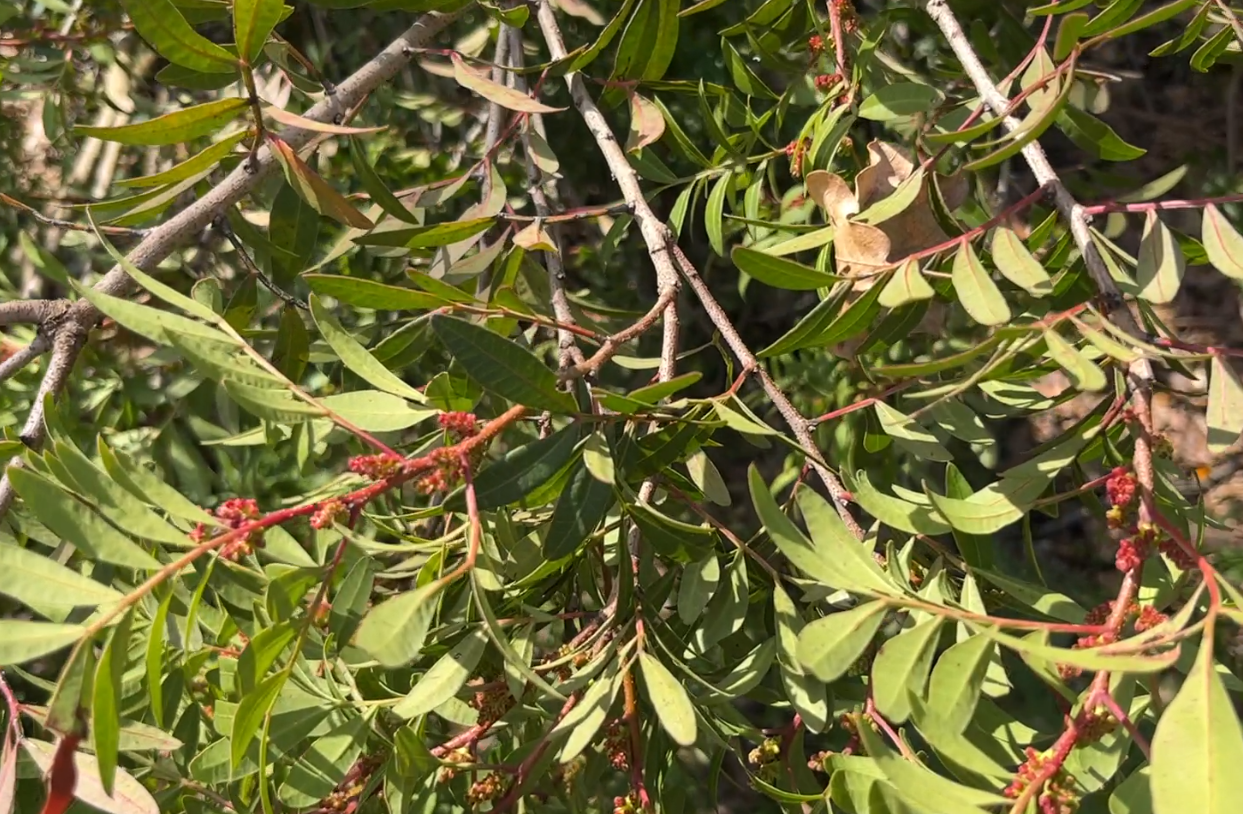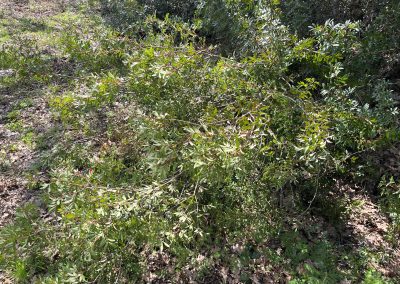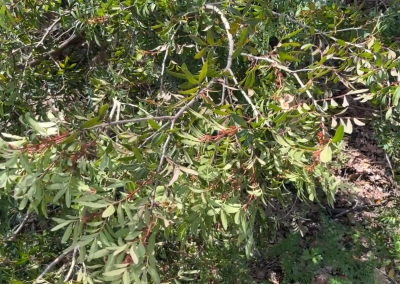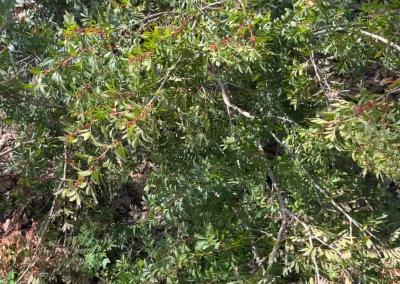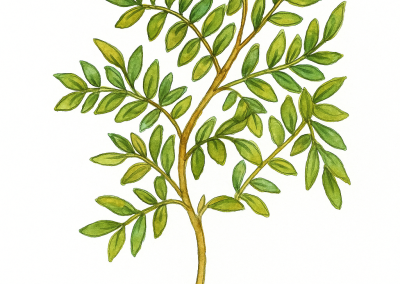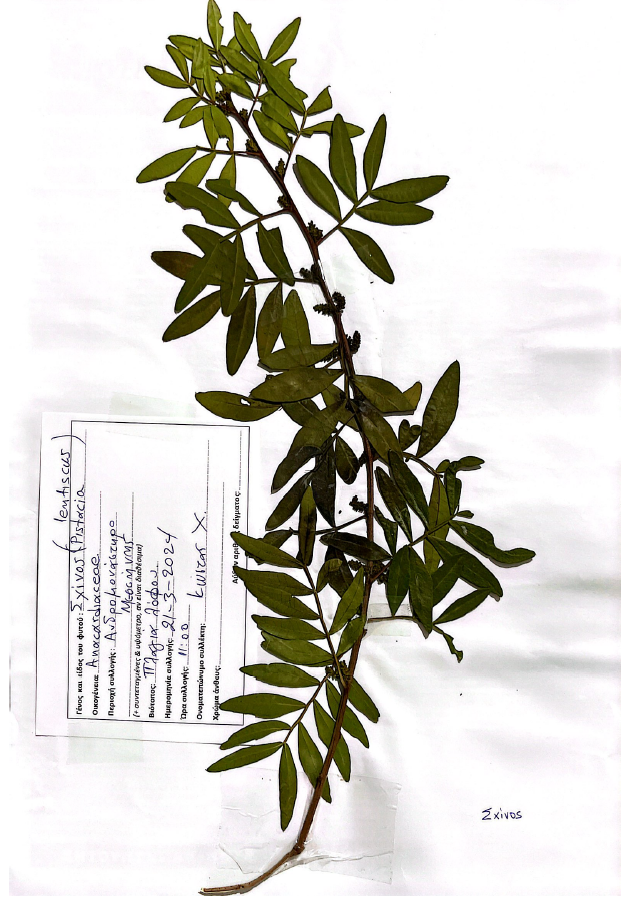Pistacia lentiscus
Scientific description
Scientific name: Pistacia lentiscus
Kingdom: Plantae
Plant species: Magnoliophyta (Magnoliophyta)
Order: Dicotyledons (Magnoliopsida), Sapindales
Suborder: Rosidae
Family: Anacardiaceae
Genus: Pistacia
Origin:
Mediterranean. The chia variety (P. lentiscus var. chia) thrives only in Chios and yields the famous mastic.
Ecology:
Grows successfully in a variety of soils, especially sandy or loamy, well-drained. Adapted to dry and poor soils.
Description:
Evergreen shrub/tree, width 6–9 m. Dense attractive foliage with small green leaflets, leathery texture, aromatic. Leaves compound, alternate, pinnate, lanceolate, sessile, deep green. Male and female flowers on separate plants; decorative fruits, pale red-pink turning glossy black.
Propagation:
Clonally via hardwood cuttings; thick branches collected from mature trees and planted in prepared aerated holes a year in advance.
Use:
Suitable for hedges, natural borders, loose Mediterranean gardens, low-maintenance or dry gardens. Fruits edible, aromatic, slightly sweet, used for flavoring food and sausages. Resin harvested for medicinal purposes: bronchial diseases, cough, diarrhea, skin ailments, stones, and stomach ulcers.
Επιστημονική ονομασία: Pistacia lentiscus
Βασίλειο: Φυτά (Plantae)
Συνομοταξία: Αγγειόσπερμα (Magnoliophyta)
Ομοταξία: Δικοτυλήδονα (Magnoliopsida), Sapindales
Υφομοταξία: Ροδίδες (Rosidae)
Οικογένεια: Ανακαρδιοειδή (Anacardiaceae)
Γένος: Πιστακία (Pistacia)
Καταγωγή:
Μεσόγειος. Η ποικιλία chia (P. lentiscus var. chia) ευδοκιμεί μόνο στη Χίο και παράγει τη φημισμένη μαστίχα.
Οικολογία:
Αναπτύσσεται σε διάφορους τύπους εδάφους, προτιμά αμμώδη ή πηλώδη, καλά στραγγιζόμενα. Πολύ ανθεκτικό σε ξηρά και φτωχά εδάφη.
Περιγραφή:
Αειθαλής θάμνος/δέντρο, πλάτος 6–9 μ. Πυκνό, όμορφο φύλλωμα με μικρά πράσινα φυλλαράκια, δερματώδη και αρωματικά. Φύλλα σύνθετα, κατ’ εναλλαγή, πτερωτά, λογχοειδή, άμισχα, βαθύ πράσινο. Άνθη αρσενικά και θηλυκά σε ξεχωριστά φυτά· καρποί διακοσμητικοί, αρχικά κόκκινοι-ροζ, μετά μαύροι και γυαλιστεροί.
Πολλαπλασιασμός:
Κλωνικά με μοσχεύματα σκληρού ξύλου. Παχιά κλαδιά από ώριμα δέντρα φυτεύονται σε γωνιές προετοιμασμένες ένα χρόνο νωρίτερα και αερισμένες.
Χρήση:
Φυτοφράκτες, φυσικά όρια, μεσογειακοί κήποι χαλαρού στυλ, κήποι χαμηλής συντήρησης, ξηροί κήποι. Καρποί εδώδιμοι, αρωματικοί, ελαφρώς γλυκείς. Ρητίνη για θεραπευτικούς σκοπούς: βρογχικές παθήσεις, βήχας, διάρροια, δερματικές παθήσεις, πέτρες, έλκη στομάχου.
Nom scientifique : Pistacia lentiscus
Règne : Plantae
Espèce de plante : Magnoliophyta (Magnoliophyta)
Ordre : Dicotylédones (Magnoliopsida), Sapindales
Sous-ordre : Rosidae
Famille : Anacardiaceae
Genre : Pistacia
Origine :
Méditerranéenne. La variété chia (P. lentiscus var. chia) ne pousse qu’à Chios et produit le célèbre mastic.
Écologie :
Croît dans divers sols bien drainés, surtout sablonneux ou limoneux. Adapté aux sols secs et pauvres.
Description :
Arbuste/Arbre persistant, largeur 6–9 m. Feuillage dense, folioles vertes coriaces et aromatiques. Feuilles composées, alternes, pennées, lancéolées, sessiles. Fleurs mâles et femelles sur plantes séparées; fruits décoratifs, rose pâle devenant noir brillant.
Propagation :
Clonale via boutures de bois dur, branches prélevées sur arbres matures et plantées dans des trous préparés un an à l’avance.
Utilisation :
Haies, bordures naturelles, jardins méditerranéens, secs, ou à faible entretien. Fruits comestibles, parfum agréable, légèrement sucrés. Résine pour usage thérapeutique : maladies bronchiques, toux, diarrhée, maladies cutanées, calculs, ulcères gastriques.
Denumire științifică: Pistacia lentiscus – Arborele de mastic
Regn: Plantae
Încrengătură: Magnoliophyta (Angiosperme – plante cu flori)
Clasă: Dicotiledonate (Magnoliopsida)
Subclasă: Rosidae
Ordin: Sapindales
Familie: Anacardiaceae
Gen: Pistacia
Specie: Pistacia lentiscus
Origine:
Regiunea mediteraneană. Varietatea chia (P. lentiscus var. chia) endemică în Chios produce rășina de mastic.
Ecologie:
Se dezvoltă bine în soluri nisipoase sau lutoase, bine drenate. Tolerant la uscăciune și soluri sărace.
Descriere:
Arbust peren, lățime 6–9 m. Frunziș compact și decorativ, frunze compuse, pinnate, textură pieloasă, parfum intens. Frunze verzi închise, lanceolate, sesile. Florile mici, verde, rareori observabile. Dioic: flori masculine și feminine pe plante separate; fructe decorative, inițial roz-pal, ulterior negre și lucioase.
Înmulțire:
Vegetativ, prin butași lignificați de la arbori maturi, plantați în gropi pregătite cu un an înainte.
Utilizare:
Ornamental: garduri vii, grădini mediteraneene, uscate, naturale; tolerant la vânt, secetă și soluri sărace. Culinar: fructe comestibile, aromate, ușor dulci, pentru aromarea mâncărurilor sau cârnați. Terapie: rășina pentru afecțiuni bronșice, tuse, diaree, ulcere gastrice, boli de piele, litiază.
Creative writing inspired by Pistacia lentiscus
Pistacia lentiscus — The Legend of the Mastic Tree
Long ago, on the ancient island of Chios, there lived a young shepherd named Lentis. Lentis was known for his wisdom and gentleness, spending his days caring for animals and speaking with the trees and plants. One of his favorite plants was the mastic tree, a humble tree that thrived on the arid hills of the island.
One day, the goddess Hera, jealous of the harmony Lentis had with nature, decided to test him. She disguised herself as an old woman and approached him, begging for some shade beneath his trees. Without hesitation, Lentis offered her shelter under the branches of the mastic tree.
However, Hera challenged him: “Do you believe that this humble tree can provide real protection?”
Lentis replied, “This tree may be small and unassuming, but it offers more than it appears. Its branches and resin are gifts from the earth.”
Impressed by his humility and wisdom, Hera revealed her true form and blessed the mastic tree. From that moment on, the tree began to produce an aromatic resin, known as mastic, which became highly prized by humans. This resin was used for making medicines and cosmetics, giving the tree a place of honor in nature.
Lentis became a legend, and his name was forever tied to the mastic tree and its magical resin, which is still considered one of nature's most precious gifts today.


